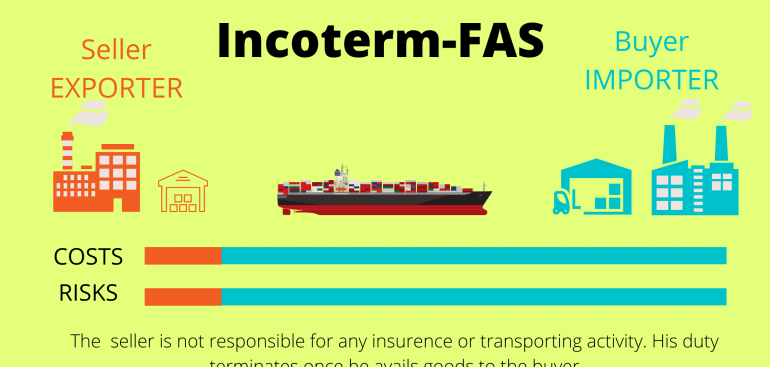FAS incoterm 2020 can be used for ocean or inland waterways shipping and is mainly used to bulk cargo. FAS term is rarely used and it isn’t used often.
FAS incoterm sellers hand over goods along with the vessel (vessel), at the nominated port. The seller delivers goods (custom cleared), to a location chosen by the buyer that is close to the vessel/ship. Seller bears all costs until then. The buyer is responsible for all activities from that point onwards.
In the contract made under the FAS Incoterm 2020 seller is responsible for the goods only till the designated port by the buyer.
Insurance: The seller is responsible for carrying the goods from the place of delivery to the ship. Buyer must arrange insurance to cover goods remaining in shipment. The buyer may request insurance from the seller, but this will be at the buyer’s expense and risk.
To understand the term FAS Incoterm 2020, let us look into the example below
Negotiation:
Let’s say that an importer in Singapore requires 10000 Metric Tons of iron ore. If a seller in India has enough iron ores, he will also export it. He can make more money by exporting iron ore than through local trading. Through an international trade fair, the seller made contact with a buyer in Singapore and began negotiations. The buyer has excellent contacts at Mumbai port and knows very few people who can handle bulk operations at Mumbai port. The buyer believes he can handle cargo operations in India. This buyer then asks the seller to go ahead with FAS Incoterm. Based on the scope of work under FAS, they finalize the commodity’s price.
Contract:
Once the seller and buyer agree to a deal with FAS Incoterm 2020 for the shipment of bulk commodities, they sign one contract/agreement.
Operations:
Seller gives timeline for iron ores delivery at the named port (Mumbai port).
Let’s assume that Singapore port is the port of discharge. The buyer contacts the Mumbai agent and makes a booking for space on a bulk vessel according to the given timeline.
After the booking is made, the buyer shares details with the agent and places of delivery. Start preparations for cargo. Contact buyer’s agent to get details such as cut-off dates, loading dates, sailing dates, etc.
Once all details have been received, the seller will contact the trucking company to transport the cargo to the Mumbai port. The seller places trucks at the seller’s factory in India, and the seller loads the cargo and takes it to the designated place at the Mumbai port close to the vessel.
With proper documentation exchanged, custom clearance occurs and cargo is handed to the agent. After the cargo is handed over, the seller’s liability ends.
The buyer’s responsibility begins. However, it’s still the seller’s obligation to arrange all shipping documents for the buyer and to hand them over.
After custom clearance is completed, the agent or Freight forwarding company begins loading cargo into the vessel with cranes.
Meanwhile, the seller approaches different offices to obtain post-shipment documents. Once the loading process is complete, the seller of the vessel will coordinate with the agent or Freight forwarding company to issue a bill of lading.
After the seller has received all pertinent documents, he will send those shipping documents to the buyer according to the agreed payment terms.
After the vessel has arrived at Singapore port, the buyer will appoint a clearing agent or Freight forwarding company to arrange clearance and transport of cargo to their warehouse. The buyer then pays for all these activities. This is FAS incoterm 2020. FAS is preferred only for bulk cargo but for containerized cargo, FCA is preferred.

